Do you have a question about the Lincoln Electric SP-135 PLUS and is the answer not in the manual?
Specific warnings regarding state-regulated chemicals and health risks.
Safety guidelines for operating and maintaining engine-powered welding equipment.
Information on potential health effects of EMF fields and mitigation procedures.
Critical warnings and procedures to prevent electric shock during welding.
Guidelines for protecting eyes and skin from harmful arc rays.
Precautions for avoiding hazardous fumes and gases generated during welding.
Measures to prevent fires and explosions caused by welding sparks.
Safe practices for handling, securing, and storing compressed gas cylinders.
Requirements for connecting welding equipment to power sources per codes.
Procedure for inspecting equipment for damage upon receipt.
Recording key identification details for future reference and parts ordering.
Instructions for registering the welding machine online or via fax.
Explanation of WARNING and CAUTION alert levels for safety information.
Details on voltage, frequency, and current needed for machine operation.
Key output parameters including amperage, voltage, and duty cycle.
Recommendations for appropriate input cable gauges and fuse/breaker sizes.
Measurements of the welding machine's height, width, depth, and weight.
Specific safety measures to prevent electric shock during the installation process.
Identifying the main welding machine unit.
Locating and identifying the welding gun and cable assembly.
Identifying the literature, contact tip, wire, and regulator included with the unit.
Guidelines for selecting an appropriate, well-ventilated operating location.
Instructions regarding machine stacking limitations and placement stability.
Overview of the machine's output terminals and connection points.
Step-by-step instructions for correctly installing the work clamp.
Procedure for routing and connecting the welding gun cable to the machine.
Instructions for connecting the shielding gas supply for GMAW processes.
Safety measures for handling cylinders to prevent explosion or damage.
Alerts regarding hazards associated with shielding gas buildup.
Proper procedure for opening and closing cylinder valves safely.
Steps for attaching the gas regulator and hose to the cylinder.
Location and description of the machine's power input connection.
Location and description of the gas solenoid inlet fitting.
Guidelines for connecting input power according to electrical codes.
Electrical requirements for achieving the machine's rated output.
Electrical requirements for utilizing the machine's maximum output capability.
Safety measures to prevent electric shock while operating the welder.
Precautions for managing hazardous fumes and gases during operation.
Safety guidelines to prevent fires and explosions during welding operations.
Protection measures against arc rays during welding operations.
Overview of the SP-135 PLUS as a DC arc welding machine.
Guidance on suitable welding processes like GMAW and Innershield.
Identification of standard controls like Power, Voltage, and Wire Speed.
Key features and benefits of the SP-135 PLUS welder.
Information on the machine's welding capacity and process restrictions.
How to use the power switch and its effect on the machine's operation.
Explanation of the voltage control for adjusting output voltage.
How to set and adjust the wire feed speed for welding.
General steps involved in preparing for and performing welding operations.
Instructions for loading wire spools, including brake adjustment.
How to adjust the friction brake for optimal wire spool tension.
Step-by-step guide for threading welding wire through the machine.
Alert regarding electrical energization of wire feed components.
Connecting and preparing the shielding gas cylinder for use.
Setting the correct gas flow rate for different welding processes.
Steps for safely shutting down the gas cylinder after welding.
Essential checks before starting a weld, including processes and settings.
Using charts to set appropriate voltage and wire speed parameters.
Ensuring proper electrical contact and grounding of the workpiece.
Techniques for initiating and sustaining a stable welding arc.
Procedure for safely stopping welding and shutting down the machine.
Important steps when changing wire types, especially between steel and aluminum.
Specific requirements and kits needed for Innershield welding.
How the circuit breaker protects against excessive output current.
Explanation of the thermostat's role in preventing overheating.
How the electronic circuit protects the wire feed motor from overload.
Recommended settings for welding various thicknesses of steel.
Recommended settings for welding aluminum, refer to manual.
Correct polarity settings for MIG and Gasless Flux-Cored processes.
Instructions for orienting drive rolls based on wire size and type.
Description of the utility cart for transporting welders and cylinders.
Details on the deluxe adjustable gas regulator and hose kit.
Kit contents and importance for welding aluminum wire.
Optional knurled drive roll for cored electrodes.
Kit for Innershield welding, including contact tip, nozzle, and liner.
Part number for the complete gun and cable assembly.
List of available contact tips for various wire sizes.
Part number for the cable liner used in wire feeding.
Part numbers for gas nozzles and diffusers.
Essential safety steps before performing maintenance on the welder.
Components with lifetime lubrication or no maintenance requirements.
Daily checks to ensure safe and proper operation.
Tasks to perform after welding, like cleaning the nozzle and tip.
Maintenance after each spool of wire, such as tip cleaning.
Tasks to perform periodically, including blowing out dust and vacuuming.
Steps for cleaning the gun cable liner to ensure smooth wire feed.
Procedures for cleaning and maintaining contact tips, nozzles, and gun tubes.
Table detailing compatible contact tips, liners, and drive rolls.
Step-by-step guide for replacing the contact tip on the welding gun.
Procedure for changing the contact tip and nozzle for Innershield wire.
Instructions for reversing or replacing the drive roll for different wire sizes.
Detailed steps for replacing the liner within the welding gun cable.
Instructions on how to open and access components within the gun handle.
Explanation of the three-step process for diagnosing and resolving issues.
Critical warnings regarding unauthorized repairs and safety during service.
Cautions related to handling machine components during troubleshooting.
Action for evident severe damage to the machine.
Diagnosing issues when the fan does not operate with the trigger pulled.
Troubleshooting steps when fan runs but there's no weld output or wire feed.
Diagnosing problems when only weld output is missing.
Diagnosing issues when wire feed fails but other functions are normal.
Troubleshooting excessive wire feed motor speed.
Addressing wire feed stopping intermittently due to overload or adjustment.
Diagnosing and resolving issues with insufficient or absent gas flow.
Identifying causes and solutions for unstable arc and poor starting.
Detailed schematic showing electrical connections and components.
Specific warnings regarding state-regulated chemicals and health risks.
Safety guidelines for operating and maintaining engine-powered welding equipment.
Information on potential health effects of EMF fields and mitigation procedures.
Critical warnings and procedures to prevent electric shock during welding.
Guidelines for protecting eyes and skin from harmful arc rays.
Precautions for avoiding hazardous fumes and gases generated during welding.
Measures to prevent fires and explosions caused by welding sparks.
Safe practices for handling, securing, and storing compressed gas cylinders.
Requirements for connecting welding equipment to power sources per codes.
Procedure for inspecting equipment for damage upon receipt.
Recording key identification details for future reference and parts ordering.
Instructions for registering the welding machine online or via fax.
Explanation of WARNING and CAUTION alert levels for safety information.
Details on voltage, frequency, and current needed for machine operation.
Key output parameters including amperage, voltage, and duty cycle.
Recommendations for appropriate input cable gauges and fuse/breaker sizes.
Measurements of the welding machine's height, width, depth, and weight.
Specific safety measures to prevent electric shock during the installation process.
Identifying the main welding machine unit.
Locating and identifying the welding gun and cable assembly.
Identifying the literature, contact tip, wire, and regulator included with the unit.
Guidelines for selecting an appropriate, well-ventilated operating location.
Instructions regarding machine stacking limitations and placement stability.
Overview of the machine's output terminals and connection points.
Step-by-step instructions for correctly installing the work clamp.
Procedure for routing and connecting the welding gun cable to the machine.
Instructions for connecting the shielding gas supply for GMAW processes.
Safety measures for handling cylinders to prevent explosion or damage.
Alerts regarding hazards associated with shielding gas buildup.
Proper procedure for opening and closing cylinder valves safely.
Steps for attaching the gas regulator and hose to the cylinder.
Location and description of the machine's power input connection.
Location and description of the gas solenoid inlet fitting.
Guidelines for connecting input power according to electrical codes.
Electrical requirements for achieving the machine's rated output.
Electrical requirements for utilizing the machine's maximum output capability.
Safety measures to prevent electric shock while operating the welder.
Precautions for managing hazardous fumes and gases during operation.
Safety guidelines to prevent fires and explosions during welding operations.
Protection measures against arc rays during welding operations.
Overview of the SP-135 PLUS as a DC arc welding machine.
Guidance on suitable welding processes like GMAW and Innershield.
Identification of standard controls like Power, Voltage, and Wire Speed.
Key features and benefits of the SP-135 PLUS welder.
Information on the machine's welding capacity and process restrictions.
How to use the power switch and its effect on the machine's operation.
Explanation of the voltage control for adjusting output voltage.
How to set and adjust the wire feed speed for welding.
General steps involved in preparing for and performing welding operations.
Instructions for loading wire spools, including brake adjustment.
How to adjust the friction brake for optimal wire spool tension.
Step-by-step guide for threading welding wire through the machine.
Alert regarding electrical energization of wire feed components.
Connecting and preparing the shielding gas cylinder for use.
Setting the correct gas flow rate for different welding processes.
Steps for safely shutting down the gas cylinder after welding.
Essential checks before starting a weld, including processes and settings.
Using charts to set appropriate voltage and wire speed parameters.
Ensuring proper electrical contact and grounding of the workpiece.
Techniques for initiating and sustaining a stable welding arc.
Procedure for safely stopping welding and shutting down the machine.
Important steps when changing wire types, especially between steel and aluminum.
Specific requirements and kits needed for Innershield welding.
How the circuit breaker protects against excessive output current.
Explanation of the thermostat's role in preventing overheating.
How the electronic circuit protects the wire feed motor from overload.
Recommended settings for welding various thicknesses of steel.
Recommended settings for welding aluminum, refer to manual.
Correct polarity settings for MIG and Gasless Flux-Cored processes.
Instructions for orienting drive rolls based on wire size and type.
Description of the utility cart for transporting welders and cylinders.
Details on the deluxe adjustable gas regulator and hose kit.
Kit contents and importance for welding aluminum wire.
Optional knurled drive roll for cored electrodes.
Kit for Innershield welding, including contact tip, nozzle, and liner.
Part number for the complete gun and cable assembly.
List of available contact tips for various wire sizes.
Part number for the cable liner used in wire feeding.
Part numbers for gas nozzles and diffusers.
Essential safety steps before performing maintenance on the welder.
Components with lifetime lubrication or no maintenance requirements.
Daily checks to ensure safe and proper operation.
Tasks to perform after welding, like cleaning the nozzle and tip.
Maintenance after each spool of wire, such as tip cleaning.
Tasks to perform periodically, including blowing out dust and vacuuming.
Steps for cleaning the gun cable liner to ensure smooth wire feed.
Procedures for cleaning and maintaining contact tips, nozzles, and gun tubes.
Table detailing compatible contact tips, liners, and drive rolls.
Step-by-step guide for replacing the contact tip on the welding gun.
Procedure for changing the contact tip and nozzle for Innershield wire.
Instructions for reversing or replacing the drive roll for different wire sizes.
Detailed steps for replacing the liner within the welding gun cable.
Instructions on how to open and access components within the gun handle.
Explanation of the three-step process for diagnosing and resolving issues.
Critical warnings regarding unauthorized repairs and safety during service.
Cautions related to handling machine components during troubleshooting.
Action for evident severe damage to the machine.
Diagnosing issues when the fan does not operate with the trigger pulled.
Troubleshooting steps when fan runs but there's no weld output or wire feed.
Diagnosing problems when only weld output is missing.
Diagnosing issues when wire feed fails but other functions are normal.
Troubleshooting excessive wire feed motor speed.
Addressing wire feed stopping intermittently due to overload or adjustment.
Diagnosing and resolving issues with insufficient or absent gas flow.
Identifying causes and solutions for unstable arc and poor starting.
Detailed schematic showing electrical connections and components.
| Brand | Lincoln Electric |
|---|---|
| Model | SP-135 PLUS |
| Category | Welding System |
| Language | English |
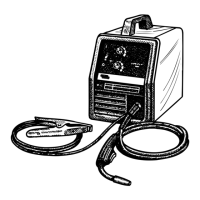
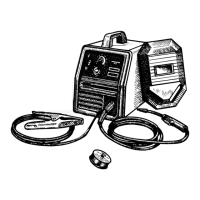
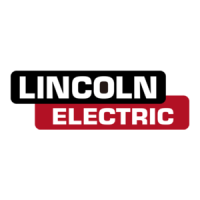
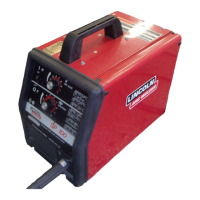
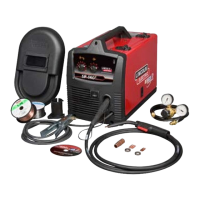
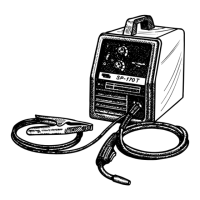
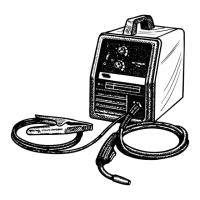
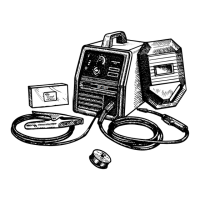

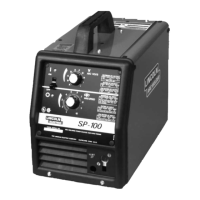


